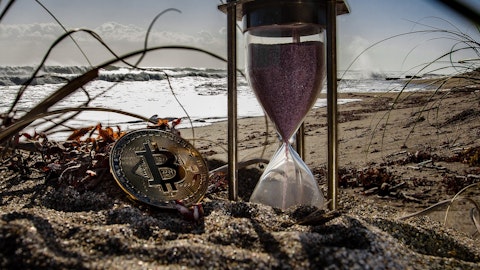So, that’s a lot more capital intensive, because those deals are much harder to finance, right, because it’s not just a legitimate financing party saying, “Hey, we’ll finance 200, 300 basis points behind the corporate credit risk.” These are start-up companies. So that’s kind of the barbell approach, and we are working both sides of that barbell. But one side is higher credit risk quality, startup-type companies that’s more capital intensive. And then the other side is longer-term contracts, much more financeable, less capital intensive, if that makes sense.
Mike Grondahl: Sure. Okay. Hey, we’ll stay tuned. Thanks, guys.
Patrick Fleury: Thanks, Mike.
Operator: Our next question comes from the line of Lucas Pipes with B. Riley Securities. Please proceed with your question.
Unidentified Analyst: Thank you very much, operator, and good afternoon, everyone. This is actually [Fedor Shabalin] (ph) asking question on behalf of Lucas Pipes. And my first one, so I believe you targeted 300 megawatts by the end of ’24 and 550 megawatts by the end of ’25 for your total self-mining footprint. And the question is, could the capacity potentially be utilized for HPC or cloud services?
Patrick Fleury: Yeah. Hi, Fedor, it’s Patrick speaking. So, yes, I think as Paul and I were saying in our remarks, we are an infrastructure company, and we are blessed in that we are long infrastructure when there’s a mass scramble for infrastructure now among both Bitcoin miners and hyperscalers, right? So, I think we — given our insider ownership, we are focused on the highest and best return on capital. And if that means Bitcoin miners, like Paul mentioned in his remarks, we’re trading at 6 times, but some of our peers are trading at 14 times, 15 times, 16 times, while data center companies out there trade at 25 times EBITDA. So, I can assure you that we are, as one of the highest insider ownership or the highest insider ownership companies in the space, we are very focused on creating long-term value, and we’ll skate to where the puck is.
Unidentified Analyst: Got it. That’s helpful. And maybe it’s early to talk about this, but would any potential HPC capacity come at Lake Mariner or Nautilus or both? What’s the preference here?
Patrick Fleury: Yeah. So, the Nautilus facility is strictly for us, it’s strictly Bitcoin mining. And then, the HPC AI capacity would come at Lake Mariner. So, as Paul said in his remarks, we have — and you’ll see in our investor deck — updated investor deck that we just posted today, we have 300 open megawatts at Lake Mariner and that will be put to the highest and best value accretive function.
Unidentified Analyst: Got you. Thank you very much. And are you having any maybe discussions today with potential tenants? And just how would you frame up the demand?
Patrick Fleury: Yes. Look, I think — Paul, I’ll answer that, but please jump in. But look, I think as we’ve mentioned to you publicly, we’ve been running a 2-megawatt pilot since the fourth quarter at Lake Mariner. We have had an adviser retained on the HPC AI front also since the fourth quarter. So, we have been in significant discussions for quite some time, and these things take time. And like I said, there’s not one solution that fits all, there’s co-location, there’s co-location and funding of all the GPUs for sort of smaller scale and then there’s much larger-scale companies that are focused on very significant size where, again, like I said, we’re not taking on the GPU technology risk because we’re not buying the GPUs. So that’s — again, I think we’re hopeful that as we move through 2024, we’ll be able to talk in more granularity about it, but it is something that our management team has been very focused on for quite some time.
And we look forward to kind of rolling that out. Paul, is there anything you want to add to that?
Paul Prager: Only in response to your question about demand, I would say demand is very, very significant and timely. I think a lot of these folks are trying to get as big as they can as fast as they can. As I said in my remarks, I think we’re one of the 10 most premier sites in the country when it comes to size, energy, availability, energy cost, access to water and of course, their unique ESG qualification. So, I think I’m very comfortable representing that our site is in meaningful demand, and we, as management, need to do our job and look at the highest value use for our property and energy.
Unidentified Analyst: Thank you so much. And maybe my last one about M&A opportunities that might evolve post halving. So, what’s your thoughts on this space? Are you looking something into more beyond these two current sites if an opportunity evolves?
Patrick Fleury: Sure. Paul, do you want me to take that, or do you want to take it?
Paul Prager: Yeah. Hey, listen, we’re trying to do — we’re trying very hard in the space that’s full of volatility and misinformation to really focus on execution. If we just stay the course here and build out our existing facilities, we’re going to be busy for quite some time. And that is the primary focus. Of course, we are familiar with energy infrastructure, unlike almost any other of our peers in this group. And so, we will be opportunistic if we find something that is compelling and has to remain true to our thesis, which is zero-carbon mining. But right now, we’re really focused on executing our business plan, keeping our heads down, doing our job and trying to make as much money as we can for our investors.
Unidentified Analyst: Thank you very much for color, and continue. Best of luck.
Operator: Our next question comes from the line of Bill Papanastasiou with Stifel. Please proceed with your question.




